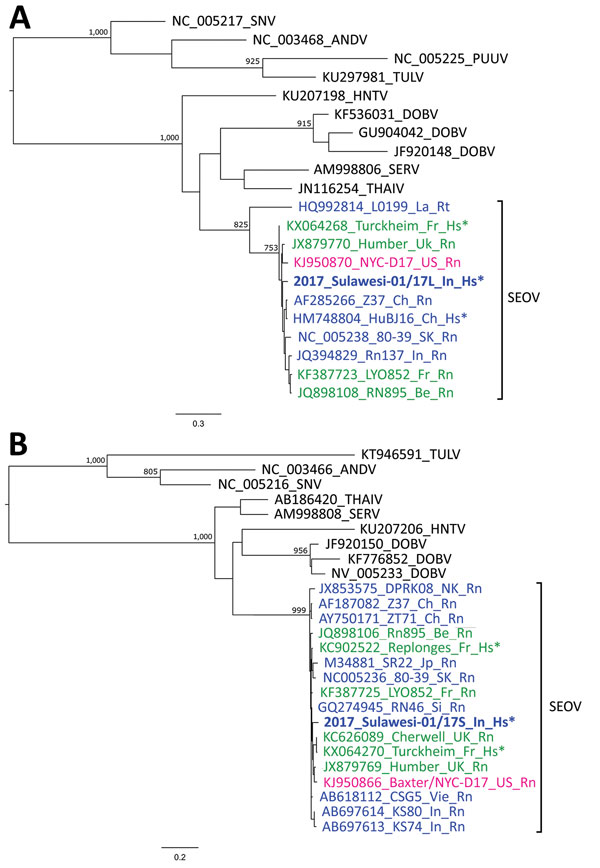Volume 24, Number 6—June 2018
Dispatch
Importation of Human Seoul Virus Infection to Germany from Indonesia
Figure

Figure. Maximum-likelihood phylogenetic trees of partial RNA segments of orthohantaviruses. A) Large RNA segments based on a 347-nt alignment and the general time reversible plus gamma distribution model of nucleotide substitution. B) Small RNA segments based on a 318-nt alignment and the Hasegawa–Kishino–Yano 85 plus gamma distribution model. Trees were constructed by using PhyML3.0 (8) and the best-fitting model according to smart model selection in this software and 1,000 bootstrap replicates. Values along branches are bootstrap values >75% for major clades. GenBank accession number, strain, country of origin, and host are shown for each virus isolate. Bold indicates SEOV isolated from the patient in this study. Blue indicates SEOV strains from Asia, green indicates SEOV strains from Europe, and red indicates SEOV strains from the Americas. Scale bars indicate nucleotide substitutions per site. *Sequences from viruses of human origin. ANDV, Andes virus; Be, Belgium; Ch, China; DOBV, Dobrava-Belgrade virus; Fr, France; HNTV, Hantaan virus; Hs, Homo sapiens; In, Indonesia; Jp, Japan; La, Laos; NK, North Korea; PUUV, Puumala virus; Rn, Rattus norvegicus; Rt, R. tanezumi; SEOV, Seoul virus; SERV, Serang virus; Si, Singapore; SK, South Korea; SNV, Sin nombre virus; THAIV, Thailand virus; TULV, Tula virus; UK, United Kingdom; US, United States; Vie, Vietnam.
References
- Kruger DH, Figueiredo LT, Song JW, Klempa B. Hantaviruses—globally emerging pathogens. J Clin Virol. 2015;64:128–36. DOIPubMedGoogle Scholar
- Lee HW. Hemorrhagic fever with renal syndrome in Korea. Rev Infect Dis. 1989;11(Suppl 4):S864–76. DOIPubMedGoogle Scholar
- Clement J, Maes P, Van Ranst M. Hemorrhagic fever with renal syndrome in the new, and hantavirus pulmonary syndrome in the Old World: paradi(se)gm lost or regained? Virus Res. 2014;187:55–8. DOIPubMedGoogle Scholar
- Goeijenbier M, Verner-Carlsson J, van Gorp EC, Rockx B, Koopmans MP, Lundkvist Å, et al. Seoul hantavirus in brown rats in the Netherlands: implications for physicians—Epidemiology, clinical aspects, treatment and diagnostics. Neth J Med. 2015;73:155–60.PubMedGoogle Scholar
- Reynes JM, Carli D, Bour JB, Boudjeltia S, Dewilde A, Gerbier G, et al. Seoul virus infection in humans, France, 2014–2016. Emerg Infect Dis. 2017;23:973–7. DOIPubMedGoogle Scholar
- Klempa B, Fichet-Calvet E, Lecompte E, Auste B, Aniskin V, Meisel H, et al. Hantavirus in African wood mouse, Guinea. Emerg Infect Dis. 2006;12:838–40. DOIPubMedGoogle Scholar
- Sibold C, Sparr S, Schulz A, Labuda M, Kozuch O, Lysý J, et al. Genetic characterization of a new hantavirus detected in Microtus arvalis from Slovakia. Virus Genes. 1995;10:277–81. DOIPubMedGoogle Scholar
- Guindon S, Dufayard JF, Lefort V, Anisimova M, Hordijk W, Gascuel O. New algorithms and methods to estimate maximum-likelihood phylogenies: assessing the performance of PhyML 3.0. Syst Biol. 2010;59:307–21. DOIPubMedGoogle Scholar
- Lin XD, Guo WP, Wang W, Zou Y, Hao ZY, Zhou DJ, et al. Migration of Norway rats resulted in the worldwide distribution of Seoul hantavirus today. J Virol. 2012;86:972–81. DOIPubMedGoogle Scholar
- Plyusnina A, Ibrahim IN, Winoto I, Porter KR, Gotama IB, Lundkvist A, et al. Identification of Seoul hantavirus in Rattus norvegicus in Indonesia. Scand J Infect Dis. 2004;36:356–9. DOIPubMedGoogle Scholar
- Ibrahim IN, Shimizu K, Yoshimatsu K, Yunianto A, Salwati E, Yasuda SP, et al. Epidemiology of hantavirus infection in Thousand Islands regency of Jakarta, Indonesia. J Vet Med Sci. 2013;75:1003–8. DOIPubMedGoogle Scholar
- Ettinger J, Hofmann J, Enders M, Tewald F, Oehme RM, Rosenfeld UM, et al. Multiple synchronous outbreaks of Puumala virus, Germany, 2010. Emerg Infect Dis. 2012;18:1461–4. DOIPubMedGoogle Scholar
1These authors contributed equally to this article.